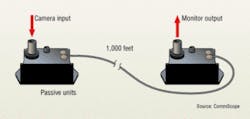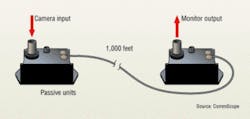Video surveillance systems are being installed in many places that in the past were not deemed in need of security. As schools, government facilities, airports, utilities, parks, and even corporate headquarters across the nation are being pressured to increase security with video surveillance systems, technology is advancing.
Designing these systems is more complex, too.
While coaxial cable has been the traditional media choice for video surveillance systems, the use of UTP and optical-fiber cable has increased significantly over the past few years. The need to ensure optimum performance for today, while considering the needs of the future, has many wondering which media type is the best for their video surveillance application.
As usual, the answer is... It depends.
Time-honored tradition
Coax cable has long been the media choice for video surveillance. Today's standard cameras and video servers are still designed to work with coax. Installing coax does not require the use of media conversion or baluns, which avoids increased costs and additional connections points.
"Reduced connection points, quick connect and disconnect, and no media conversion continues to make coax the most reliable and cheapest solution for many applications," says Rob Wessels, vice president of engineering, CommScope (www.commscope.com). "For many years, the distance limitation of coax was specified at 750 feet, but with today's high quality coax and camera technology, that's really just an old wives tale."
With a gauge size of 18, coax offers more usable bandwidth than UTP and delivers a slightly higher quality picture. "The larger gauge size of coax cable provides better attenuation," says Mike Rubera, director of technical support of Mohawk/CDT (www.mohawk-cdt.com). "The coax shielding also means better EMI and RFI protection than UTP."
According to Darryl LeDoux of California-based RFI Communications and Security Systems, most installations are done with a combination of coax and power cable. "At some point, Category 6 or fiber-optic cable may do everything we want it to do and come down in cost, but it's not happening right now—especially in this economy where cost is an issue," says LeDoux.
Camera manufacturers like Panasonic still recommend coax as the best transmitting media for today's video surveillance systems. "We've tested and proven that video can run 3,000 feet over coax with our cameras, which include built-in equalizers," claims Thomas Cook, national sales manager, Panasonic Security Systems Group (www.panasonic.com).
While coax continues to be a high performing solution, most security industry professionals admit that it's not always cut and dry. "Each media type has its own advantages and disadvantages, and there will always be applications where coax isn't the best choice," says Cook.
Doing it all
While some enhanced Category 6 UTP cable has recently been promoted specifically for video surveillance, most industry professionals know that UTP has been capable of transmitting video for quite some time. "Promoting enhanced Category 6 cable for video surveillance is really about using less and getting more," says Asef Baddar, application engineer for General Cable (www.generalcable.com). "Everyone still agrees that coax provides a better picture because of its gauge size. But instead of running one type of cable for voice and data and another for video surveillance, UTP cable can do everything, including provide power." According to Baddar, even Category 5 cable has been proven to work well for video surveillance systems.
UTP cable's EMI and RFI protection is not as good as shielded coax cable, and UTP requires either network-based cameras or baluns at each end, which adds more points of possible failure. "While some new cameras incorporate an [8-pin modular] connection or USB port, utilizing baluns at both ends to accommodate the coaxial port is still the most common and least expensive method of using UTP for video surveillance," says Wessels. He says UTP can be installed as a passive surveillance system up to 1,000 feet, or as an active system with an amplified signal on both ends, up to as much as 7,000 feet.
"We've tested video over UTP in an active system with amplification on just one end, and we achieved acceptable results at 4,000 feet," says Wessels. "However, the picture quality is better at about 3,000 feet."
For environments where moves, adds, and changes are common or camera densities high, UTP cable provides a structured cabling scenario with plug-and-play capability. "When space is limited or hundreds of cameras are needed, like in casinos, home running huge amounts of bulky coax is not practical," says Wessels. "That's where multi-pair lightweight UTP is an advantage without the high cost of going to fiber. UTP also integrates well with existing structured cabling, and old UTP cable abandoned due to upgrades can be used for video surveillance rather than pulling all new cable."
Video surveillance and voice-data systems still utilize separate dedicated pairs in the horizontal and backbone, and are, therefore, not yet a true converged network. UTP's familiarity and serviceability makes it the cable of choice among IT professionals. "Coax is an RF world where you have to worry about power levels, but IT professionals understand the digital plug-and-play world of UTP with jacks and cords," says Mohawk/CDT's Rubera. "For example, schools that don't have the skills or money to maintain an RF system use UTP for video surveillance and distance learning, and they often convert incoming cable TV to UTP with a video distribution unit for branching out to classrooms."
Safe and secure advantage
Common industry knowledge says that optical-fiber cable transmits signals for much longer distances with no degradation. "While 90% of the fiber installed for security is multimode, singlemode fiber is widely used in the transit industry," says Sanford Green, director of North American sales and security for GE Interlogix video systems group (www.ge-interlogix.com). "To be able to extend a surveillance system for hundreds of miles is a great advantage, but distance isn't the only advantage to using fiber."
Unlike copper, fiber does not radiate energy and is extremely difficult to tap into, which is why the military exclusively deploys it. "Sometimes, a lot of important information is sent over the video surveillance system, and industrial espionage is a big business throughout the world," says Green. "Fiber is really the only media that offers high security."
Optical-fiber cable is immune to all signal noise, short circuits, and power surges. "If a video surveillance system is being installed in a high frequency environment, such as an airport or hospital, I would not take a chance with coax or UTP," says Panasonic's Cook. "Fiber should also be considered anytime the surveillance system runs outdoors. During a lightning strike, conductive coax and UTP cable could cause the loss of expensive equipment." Because fiber is nonconductive, however, it cannot be used to provide power, and a separate power source is required for cameras and equipment.
Other harsh environments, such as power plants and factories, may also benefit from using optical-fiber cable. "A camera installed in a 400-foot office hallway will probably utilize coax; however, a camera running 400 feet in an oil refinery must use fiber, as the probability of fiber creating a spark or fire is zero," says Ed Davis, vice president of American Fibertek (www.americanfibertek.com), a manufacturer of optical-fiber transmitters and receivers for security and surveillance systems.
Using optical-fiber cable for video surveillance requires media conversion at both the transmitting and receiving ends. In general, optical-fiber electronics carry a higher price tag, but according to Davis, the cost comparison between coax and fiber can be deceiving. "To install a 500-foot camera run would certainly be more expensive with fiber than with coax," says Davis. "However, when an application includes many cameras, the overall cost of running conduit and coax or UTP may be the same, if not more, than using fiber." Like UTP, fiber offers a lightweight and compact design for easy installation. In fact, coax is eleven times heavier than fiber, and eight fibers equal the diameter of one RG-11 coax cable.
Optical-fiber cable also offers the benefit of using existing fiber backbone cabling and putting multiple signals over one fiber. "If a customer has a camera on one fiber and needs to add more, the electronics can be simply changed," explains Davis. "With coax, another cable would have to be added; therefore, fiber guarantees long life of a cabling infrastructure."
Time will tell
Distance, interference, power, bandwidth, ease of installation, security, camera density, and overall system cost vary with each video surveillance system installation. While selecting a media type depends on all of these factors, industry professionals have varying opinions about which is best and what the future holds.
"While many are going with a structured cabling environment, UTP definitely degrades the signal and coax still offers better quality," says Panasonic's Cook. "Installing cameras is easy. Installing cable is more intensive. It's important to put in a cable that the end user will be happy with from the start, because it costs a lot for them to replace it."
Although UTP and fiber offer several advantages, Mohawk/CDT's Rubera believes there will always be applications for coax: "We may not see coax in areas that have traditionally been only coax, but we'll continue to see it for situations that require high power, ultra-low loss, and good shielding."
Many in the cabling and IT industries believe UTP to be the new best media type for video surveillance. If UTP cable is being pulled throughout a building for voice and data networks, using the same media for video surveillance provides consistency in terms of what has to be maintained. "We'll definitely see more UTP for video surveillance," says CommScope's Wessels. "Is that because it's better than coax? No; however, UTP does offer certain benefits, and many people want to take advantage of them."
Manufacturers like American Fibertek and GE Interlogix that are involved in providing optical-fiber solutions for the security industry are convinced that the only media that can respond to the continued need for higher bandwidth and cleaner transmission signaling is optical-fiber cable. "As we look at the merger of security and IT, we see that fiber is certainly growing with an estimated 25 to 30% of video surveillance installs," says Green of GE Interlogix. "Today, everything comes coax-ready with an analog signal, so media conversion is still required.
Betsy Ziobron is a freelance writer covering the cabling industry, and a regular contributor to Cabling Installation & Maintenance. She can be reached at: [email protected]

